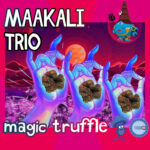However, the mythology of the Philosopher’s Stone dates back far, far earlier than the 90s. In this article we delve into its history, and if the Philosopher’s Stone could really be… a magic truffle?!
The Legend of the Stone
The Philosopher’s Stone (or lapis philosophorum in Latin) is a mythical substance, used in the ancient field of Alchemy. Legend has it, it has the power to transform base metals into gold, cure all disease and bestow immortality on the user. Its first recorded mentions date back to 300AD in Ancient Greece, and it is also referenced in biblical verse. Its equivalent exists in Buddhism and Hinduism, known as Cintamani, a wish fulfilling jewel.
The conventional imagery of the Alchemist searching for the Philosopher’s Stone, is that of an old man hunched above smoking and bubbling cauldrons. He squints at test tubes and melts metals down in a bid to achieve riches. However, at its base, Alchemy is actually the study of the philosophy of nature.
The Gold of the Mind
However, a school of thought suggests that the ‘gold’ that the Philosopher’s Stone creates is, in fact, metaphorical. Rather, the alchemist’s quest for the perfection of nature is actually enlightenment itself . The gold of the mind. Additionally, the ‘immortality’ granted by the stone can be interpreted as freedom from the ego, and connection with the spiritual self. The Secret Doctrine is quoted as saying;
(The user of the Philosopher’s Stone) “finds himself both linked to his external body, and yet away from it in his spiritual form. The latter, freed from the former, soars for the time being in the ethereal higher regions, becoming virtually ‘as one of the gods.”
Sound Familiar?
Wait a minute… that sounds familiar?! Well actually, to many it does. There has long been a theory that the Philosopher’s Stone is neither just a stone or a code for enlightenment. It’s actually a bit of both. Some people believe that the Philosopher’s Stone is in fact a magic truffle!
Think about it. The small, knobbly sclerotia could easily be referred to as ‘stones’. And well, philosophically speaking, they do gift the mind riches. Riches of enlightenment, and ego death that, for some, is immortality. The use of psychedelics to expand the mind or for ceremonial purposes has been a human practice for millennia. It is very possible that Medieval alchemists were using psychedelics for the same goals.
The Power to Heal
Additionally, as new research is proving, the active ingredient in magic truffles, psilocybin does have the ability to heal. Disorders such as depression, OCD and PTSD have all been shown to be greatly improved by psilocybin treatment.
“Not of Stone, Not of Bone, Not of Metal”
It is also said that the Philosopher’s Stone is “not of stone, not of bone, not of metal.”. This of course leaves plants, and in that bracket, fungi.
So, if it heals, it enlightens, it brings spiritual immortality… It must be a magic truffle! Orrrr a Philosopher’s Stone.
Or, most likely, both.





